.
Cap Devices
.
Because the WAAC did not receive military status, no official
Army insignia could be worn by its personnel. Instead, a distinctive eagle
was chosen as special WAAC insignia.
.
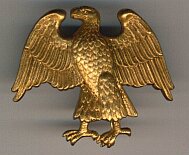
WAAC Cap Device,
Officers
|
..... |
This WAAC eagle was commonly nicknamed as “walking duck/buzzard”
because of its slanted appearance.
It was worn as cap device on the service cap and also embossed on
the plastic buttons of the service uniforms. |
..... |

WAAC Cap Device,
Enlisted Personnel
|
.
With transformation into the WAC between July and September 1943,
the Army Eagle was adopted as hat insignia.
.
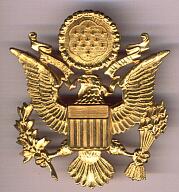
Army Cap Device,
Officers
|
.... |
This was possible because the WAC was established as integral part
of the Army now. Thus, procurement and distribution for the Army's Quartermaster
office could be simplified.
During a changeover period, the WAAC eagle as well as the Army Eagle
was worn. |
.... |
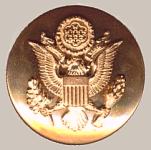
Army Cap Device,
Enlisted Personnel
|
.
| If authorized, enlisted personnel was allowed to wear disitinctive
corps insignia on their garrison caps. The insignia had to be pinned on
the left side of the garrison caps, 1 1/2 center from the front center,
centered on the curtain.
Officer's wore their rank insignia on the left
side of the garrison cap, 1 inch from the front center. |
...... |
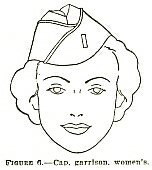 Correct wear of garrison
cap with officer's rank pin
Correct wear of garrison
cap with officer's rank pin
|
.
Collar and Lapel Insignia
.
Apart from the US insignia, the helmeted head of Pallas Athene was
chosen as collar or lapel insignia, “Greek goddess of wisdom, victory and
of crafts – to symbolize the work and purpose of the WAC”.
.

Cut-out US Insignia
worn by WAAC/WAC Officers
|
.. |

Cut-out Pallas Athene Insignia
worn by WAAC/WAC Officers
|
....... |
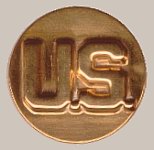
Disc-mounted US Insignia
worn by enlisted WAAC/WAC personnel
|
.. |
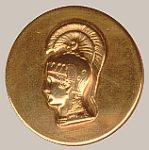
Disc-mounted Pallas Athene
worn by enlisted WAAC/WAC personnel
|
Collar and lapel insignia consisiting of the
US insignia and the Pallas Athene (or sometimes the insignia of another
Army branch) were worn on the service jacket, wool field jacket (ike jacket),
shirtwaist (if the jacket was removed), WAC off-duty dress and WAC hospital
dress. No collar and lapel insignia were worn on the overcoats, raincoats
or M43 field jackets.
.
| WAAC enrolles who hadn't been issued the uniform
yet wore a WAAC Enrollee pin on their civilian clothes. |
..... |
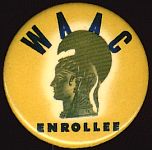 |
.
Placement of Collar and Lapel
Insignia
Placement of Collar and Lapel insignia on the
Service Uniform
.
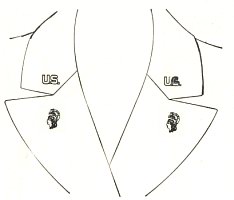
WAAC/WAC Officer
|
.... |
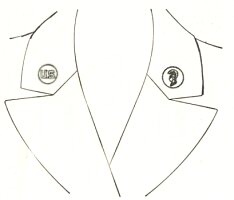
Enlisted WAAC/WAC
|
.
Placement of Collar and Lapel Insignia
on the Wool Field Jacket (Ike Jacket)
.
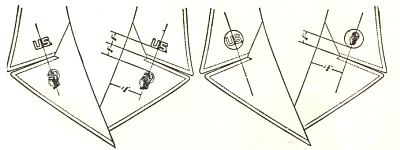
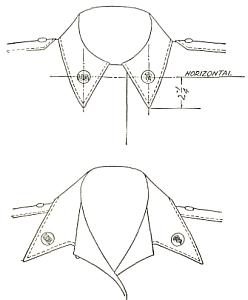 |
... |
Left: Placement of Collar
Insignia on the WAC Off-Duty Dress
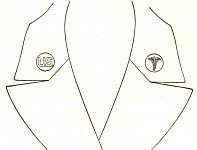
Placement of Insignia on the
WAC Hospital Dress. Note Enlisted Medical Corps Insignia on the left collar.
|
.
"Pallas Athene" versus Arm or
Service Insignia of Male Personnel
.
The War Department directives prescribed the wearing of the Pallas Athene
as distinctive branch insignia by all WAAC members. However, this was not
always the case in practice. At many air bases and some signal corps stations
the WAAC personnel were ordered to wear the same branch insignia as men
assigned to the same job. Even the Inspector General ordered the WAAC officers
of his office to violate War Department directives by putting on Inspector
General insignia.
When the Women’s Army Corps was created, however, it was not designated
as a basic branch. Instead, it became the only Army component with its
own insignia. The question if the Pallas Athene insignia should be replaced
by Army branch insignia arose frequently at field stations. While the Army
Air Forces pleaded for the wear of the same branch insignia as men, the
Army Ground Forces disagreed intensely. The Army Service Forces were divided
in their opinion.
The faction who wanted the WAC to continue the wear of the Pallas
Athene after leaving the training centers considered the WAC to be a separate
component not requiring branch insignia. This faction claimed possible
administrative complications if Army branch insignia would be worn by a
WAC member. Most importantly, men were horrified by the idea of women wearing
combat branch insignia like cannons, sabers or crossed rifles (artillery,
cavalry, infantry) on their uniforms.
Arm or Service Insignia
.
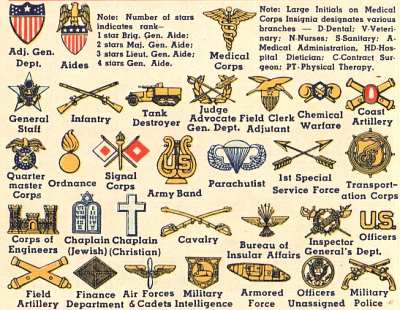
The first WAC regulations avoided a clear statement regarding this
topic. The result was further confusion. While the Air Forces authorized
the change of insignia, the Ground Forces did not. Various other services
left the decision to the field stations.
Finally, in 1945, the following different policies were permitted
for the three major Army branches:
| * |
In the Army Air Forces, all WACs
were entitled to wear the Air Corps or ASWAAF (Arms and Services with the
Army Air Force) insignia. |
| * |
In the Army Service Forces, WAC
members were also ordered to wear the insignia that a man assigned to the
same job would have worn. |
| * |
In the Army Ground Forces the women
were forbidden to wear the insignia of any Army Ground Forces command (Infantry,
Cavalry, Field Artillery, Coast Artillery Corps, Armored Center and units,
and Tank Destroyer). |
Additionally, all officers assigned
to the Judge Advocate General’s Department, the Medical Department and
the Corps of Chaplains were not allowed to wear the corresponding insignia.
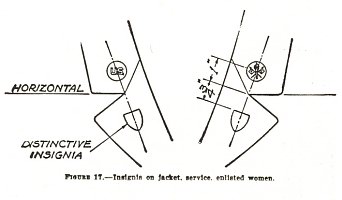 1945 introduced Placement of Insignia
on the Service Jacket of Enlisted Women. Note: Branch insignia of the Signal
Corps on the collar and additional distinctive insignia (if authorized)
on the lapels.
1945 introduced Placement of Insignia
on the Service Jacket of Enlisted Women. Note: Branch insignia of the Signal
Corps on the collar and additional distinctive insignia (if authorized)
on the lapels. |
..... |
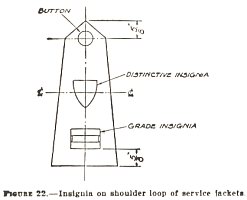 Distinctive Insignia (if authorized)
were also added to the shoulder loops on the service jacket of officers
in 1945.
Distinctive Insignia (if authorized)
were also added to the shoulder loops on the service jacket of officers
in 1945. |
.
Buttons
.
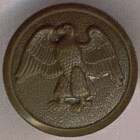
WAAC Plastic Button.
|
....... |
All WAAC Personnel wore the WAAC eagle embossed on olive-drab plastic
buttons on their service uniforms. The use of plastic as material was a
measure to conserve metal. |
..
| After conversion to the WAC, the WAAC plastic buttons were replaced
by US coat of Arms buttons.
While officers received the regular gilt Army buttons, enlisted WAAC
personnel was equipped with olive-drab plastic buttons embossed with the
regulation coat of Arms of the United States instead of the WAAC eagle. |
..vv |
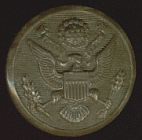 OD Plastic US
OD Plastic US
Coat of Arms Button
|
.
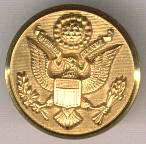
Gilt US Coat of Arms
Button
|
.... |
It was the summer of 1944 when enlisted personnel received regulation
gold-colored buttons as well. The situation on brass had become less critical
and the gilt buttons were favored to brighten up the criticized drabness
of the uniforms of enlisted WAC personnel. |
.
. |

